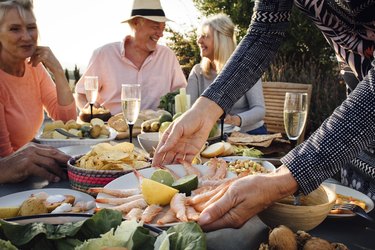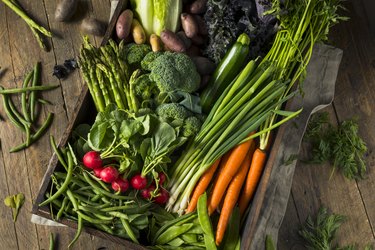
This article is for informational purposes only. The content is in no way sponsored or endorsed by Blue Zones.
Diets come from just about everywhere. Some are named after the people who create them (think: Atkins, Dubrow) and others after the institutions that back them (the Mayo Clinic Diet, for example). Still others come from a specific region of the world.
The most famous in the latter category may be the much-lauded Mediterranean diet, but the blue zones diet is another healthy way of eating that deserves a look.
Video of the Day
Video of the Day
There's obviously no country or region on the map called "The Blue Zone," but the diet actually stems from five areas around the globe — where people tend to live the longest, healthiest lives.
What is the blue zones diet?
The blue zones diet incorporates eating patterns from five regions: the Barbagia region of Sardinia; Ikaria, Greece; Nicoya Peninsula, Costa Rica; Okinawa, Japan and Loma Linda, California.
These regions were determined by Dan Buettner, the founder of Blue Zones, who identified these "longevity hotspots" and then assessed the lifestyles of the people who lived there, creating what is today known as the Blue Zones lifestyle.
The blue zones diet is one facet of that lifestyle, which is described as the Power 9. These are the key tenets to living a healthy and prosperous life.
Some of these tenets include moving naturally, having a sense of purpose and putting loved ones first. The diet has three tenets and they include:
- 80 Percent Rule: This rule is based on an Okinawan mantra said before a meal, which reminds the person to stop eating when his stomach is 80 percent full. Leaving the 20 percent gap between not being hungry and feeling full could be the difference between losing weight or gaining it.
- Plant Slant: Beans and vegetables are the cornerstones of the blue zones diet. Meat is eaten only four to five times per month and in small portions.
- Wine at 5: People in the blue zones (except for the Adventists who abstain from all alcohol) drink alcohol moderately and regularly. One to two glasses per day is advised, with friends and/or with food.

Benefits of the Diet
Like any diet, there are pluses and minuses to the blue zones plan, but the positives outweigh the negatives. Here's the breakdown on the benefits:
1. It promotes being social: Many other diets have strict eating windows or types of food that you can or cannot eat, making eating with others near impossible. The blue zones diet actually advocates for eating and drinking socially, which may make it more enjoyable than other diets.
2. It's good for the planet: The blue zones diet is 95 to 100 percent plant-based, which means it's good for your health and the health of Mother Earth.
3. You can still enjoy wine: If you enjoy a nightly glass of wine, this is still encouraged, unlike many other diets where alcohol is not allowed.
4. It's high in fiber: Beans, vegetables, fruits, nuts and whole grains — these are the foundation of a blue zones diet, and they also happen to be filled with soluble and insoluble fiber. Getting enough dietary fiber has been linked to weight loss as well as gut and heart health.
5. No wild diet foods/drinks required: This diet is rooted in whole, nutrient-rich foods that are easy to find in your local supermarket, not gimmicky, expensive diet foods or supplements.
Potential Drawbacks of the Diet
1. Requires cooking/preparation: Because much of the diet is focused on eating whole, nutrient-rich foods, you'll need to learn how to prepare and combine these foods to make various meals. If you're not used to this, and typically rely on more highly processed foods, this can be a challenging transition.
Related Reading
2. Palatability of foods: If eating whole, minimally-processed foods is new to you, there will be an adjustment period as you transition off highly processed foods that are typically high in sodium and added sugar. After a week or two, your taste will change and you'll notice changes in how your body feels on these more nutrient-dense foods.

What do you eat on the blue zones diet?
The blue zones diet recommends eating with family and friends often, and your diet should be 95 to 100 percent plant-based. There is a focus on eating "wholly whole foods," which are single-ingredient, raw, cooked, ground or fermented, and not highly processed.
Here are the foods that will predominately make up your diet on a daily basis, according to the Blue Zones Food Guidelines:
Vegetables
- Leafy greens (kale, collard greens, turnip tops, Swiss chard, spinach, etc.)
- Broccoli
- Cauliflower
- Asparagus
- Cabbage
- Celery
- Carrots
- Cucumber
- Brussels sprouts
- Radishes
Fruit
- Apples
- Oranges
- Grapes
- Bananas
- Strawberries
- Raspberries
- Blueberries
- Plums
- Peaches
- Blackberries
Whole Grains
- Oats
- Spelt
- Teff
- Buckwheat
- Barley
- Farro
- Quinoa
- Wild rice
Beans: Eat a half-cup to 1 cup per day.
- Kidney beans
- Chickpeas
- Navy beans
- Black beans
- Pinto beans
- Cannellini beans
Beverages
- Water — drink about seven glasses per day
- Coffee (in moderation)
- Tea (in moderation)
- Wine (in moderation)
Nuts: Enjoy one to two handfuls per day.
- Pistachios
- Almonds
- Cashews
- Walnuts
- Pecans
- Brazil nuts
- Pine nuts
Fermented Foods:
- Tofu
- Wine
- Sourdough bread
- Pickled vegetables
Fish: Eat fewer than 3 ounces, three times a week.
- Salmon
- Sea bass
- Trout
- Mahi-mahi
- Mackerel
- Cod
Foods to Limit or Avoid on the Diet
Eggs: Eat no more than three per week.
Sugar: Consume no more than 28 grams (7 teaspoons) of added sugar per day.
- Soda
- Sweetened teas, juices and cocktails
- Candy
- Cookies, cakes and pastries
- Ice cream
- Sugary cereal and yogurts
Dairy: Reduce overall intake
- Milk
- Yogurt
- Cheese
- Ice cream
- Yogurt
Meat: Blue zone centenarians eat about 2 ounces or less five times per month.
- Beef
- Chicken
- Turkey
- Pork
Highly-Processed Foods: Eat rarely.
- Fried food
- Sugary and salty snacks
- Foods with artificial flavors, sweeteners and coloring

Is the blue zones diet healthy?
Yes. The diet was created by analyzing the diets (and lifestyles) of the healthiest and longest-living groups of people in the world.
One of the main tenets, "plant slant," is focused on making 95 to 100 percent of your diet plant-based. Eating a plant-based diet and relying on foods like beans and tofu for protein is linked to living longer, according to an August 2019 study in JAMA.
Plant-based diets are also associated with a lower risk of type 2 diabetes, per a July 2019 paper in JAMA.
Related Reading
Hara hachi bu, or eating until you're about 80 percent full, is another key tenet of the blue zones diet. This mantra and way of eating comes from the Okinawan diet and is a helpful approach to reducing mindless overeating, which can result in weight gain, according to the Cleveland Clinic. The Okinawans also have some of the lowest rates of cancer, heart disease and stroke.
Wine at 5 is the last tenet related to diet as part of the blue zones diet. Interestingly, the research on drinking wine isn't black and white. We often hear about the heart-healthy benefits of drinking red wine and while moderate wine consumption — one glass per day for women and two for men — is considered to be safe, per the American Heart Association, the science on the benefits is mixed.
Bottom line: Should you try it?
Absolutely! This is a plant-based diet focused on eating minimally processed foods, which is in line with the recommendations laid out in the Dietary Guidelines for Americans.
If you often engage in endurance or high-intensity exercise, just make sure to check with your doctor or dietitian to ensure you're getting the extra calories you need for these activities.
- Blue Zones: "History of Blue Zones"
- Blue Zones: "Food Guidelines"
- Journal of the American Medical Association: "Association of Animal and Plant Protein Intake With All-Cause and Cause-Specific Mortality in a Japanese Cohort"
- Journal of the American Medical Association: "Association Between Plant-Based Dietary Patterns and Risk of Type 2 Diabetes A Systematic Review and Meta-analysis"
- Cleveland Clinic: "Don’t Eat Until You’re Full ― Instead, Mind Your Hara Hachi Bu Point"
- American Heart Association: "Is drinking alcohol part of a healthy lifestyle?"
- U.S. Department of Health and Human Services: "2015-2020 Dietary Guidelines"